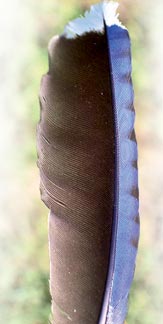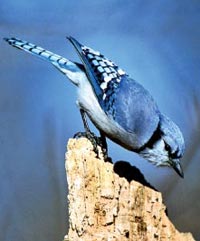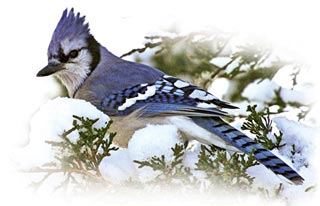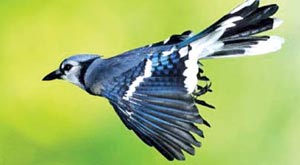|
Nature trail
Intelligent feathered beauties
Blue jays
Last week we introduced you to a spectacular species of bird that
most of you would undoubtedly have been fascinated with. Today too we
like to familiarise you with yet another striking avian friend, the Blue
Jay (Cyanocitta cristata) which is a passerine bird, and a member of the
Corvidae family.This bird is not common in our Motherland because it is
a native of North America. It belongs to the "blue", Canadian or
American jays, which are, among the Corvidae, not closely related to
 other
jays. other
jays.
As we are not likely to come across any of these vibrantly hued jays
in our Motherland, let's check out some interesting facts about these
members of the avian family.
Birds no matter which species they belong to never fail to amaze us
with their colourful feathers, beautiful songs or special traits. The
Blue Jay too is one such feathered beauty which measures 22-30 cm (9-12
in) from bill(beak) to trail. It weighs about 70-100 grams (2.47-3.53
oz), with a wingspan of 34-43 cm (13-17 in).
If you look closely at the bird's photographs featured here you may
notice that it has a pronounced crest on its head. Now if you are
wondering what a crest is, it is a crown of feathers, which may be
raised or lowered according to the bird's mood. When excited or
aggressive, the crest may be fully raised and when frightened, the crest
may spread outward like the bristles in a hair brush. There is hardly
any evidence of this crest when the bird is feeding among other jays or
resting. The crest is generally flattened to the head at such times.
Going by its name alone (even if you had not seen the photographs)
you may naturally think that the bird is blue in colour. Yes, the blue
jay has a plumage which is lavender-blue to mid-blue in the crest, back,
wings, and tail while its face is white.
The underside is off-white and the neck is collared with black which
extends to the sides of the head. The wing primaries and tail are
strongly barred with black, sky-blue and white. But the bird's bill,
legs, and eyes are all black. Males and females are almost identical
except that males are slightly larger in size.
Here is some fascinating information about the colouration of most
blue birds. As with other blue-hued birds, the Blue Jay's colouration
too is not derived by pigments. It is the result of light interference
due to the internal structure of the feathers. This is referred to as
'structural colouration'. If you ever come across the feather of such a
blue hued bird try crushing it. You will be surprised to see the blue
disappear as the structure is destroyed.

Did you know that these birds have strong black bills which they use
for cracking nuts and acorns and also for eating corn, grains and seeds?
However, their menu does not stop at these; they also eat insects such
as beetles, grasshoppers, and caterpillars.
We know that birds have the ability to make various sounds, some of
which are truly melodious. Blue Jays too can make a large variety of
sounds, and individuals
 may
vary in their calling style. As most corvids, learn to mimic human
speech, Blue Jays can also copy the cries of local hawks so well that
sometimes people in the area have found it difficult to tell which it
is. Among the typically varied sounds these birds make, the most
commonly recognised sound is said to be the alarm call, which is a loud,
almost seagul-like scream. There is also a high-pitched jayer-jayer call
that increases in speed as the bird becomes more agitated. This
particular call can be easily confused with the chick-a-dee's song
because of the slow starting chick-ah-dee-ee. may
vary in their calling style. As most corvids, learn to mimic human
speech, Blue Jays can also copy the cries of local hawks so well that
sometimes people in the area have found it difficult to tell which it
is. Among the typically varied sounds these birds make, the most
commonly recognised sound is said to be the alarm call, which is a loud,
almost seagul-like scream. There is also a high-pitched jayer-jayer call
that increases in speed as the bird becomes more agitated. This
particular call can be easily confused with the chick-a-dee's song
because of the slow starting chick-ah-dee-ee.
Blue Jays will use these calls to band together to mob potential
predators such as hawks and drive them away from the jays' nests.
Blue Jays also have quiet, almost subliminal calls which they use
among themselves in proximity. One of the most distinctive calls of this
type is often referred to as the "rusty pump" owing to its squeaky
resemblance to the sound of an old hand-operated water pump.
The Blue Jay (and other corvids) are distinct from all other
songbirds for using their call as a birdsong.The Blue Jay occurs from
southern Canada through the eastern and central USA south to Florida and
northeastern Texas. The Western edge of the range stops where the arid
pine forest and scrub habitat of the closely related Steller's Jay (C.
stelleri) begins.
Recently, the range of the Blue Jay has extended northwestwards so
that it is now a rare, but regularly-seen winter visitor along the
northern US and southern Canadian Pacific Coast.Jays are quite common in
the San Francisco Bay Area in California. As the two species' ranges now
overlap, C. cristata may sometimes hybridize with Steller's Jay.
The northernmost subspecies C. c. bromia is migratory, subject to
necessity. It migrates during the daytime, in loose flocks of 5 to 250
birds.
The Blue Jay occupies a variety of habitats within its large range,
from the pine woods of Florida to the spruce-fir forests of northern
Ontario. It is less abundant in denser forests, preferring mixed
woodlands with oaks and beeches. It has expertly adapted to human
activity, occurring in parks and residential areas, and can adapt to
wholesale deforestation with relative ease if human activity creates
other means for the jays to get by.The Blue Jay is known to be a
moderately slow flier and therefore an easy prey for hawks and owls,
when it flies in open lands.

It flies with body and tail held level, with slow wing beats. It has
also been known to sound an alarm call when hawks or other dangers are
near, and smaller birds often recognise this call and hide themselves
away accordingly. It may also be aggressive towards humans who come
close to its nest, and if an owl roosts near the nest during the daytime
the Blue Jay mobs it until it takes a new roost.
Its food is sought both on the ground and in trees and includes
virtually all known types of plant and animal sources, such as acorns
and beech mast, weed seeds, grain, fruits and other berries, peanuts,
bread, meat, small invertebrates of many types, scraps in town parks,
bird-table food and rarely eggs and nestlings.
Blue Jays will sometimes cache(store) food, though to what extent
differs widely among individuals.
When it comes to making a home for the offspring, any suitable tree
or large bush may do, though an evergreen is generally preferred. The
nest is preferentially built at a height of three to 10 m. It is
cup-shaped and composed of twigs, small roots, bark strips, moss, other
plant material, cloth, paper, and feathers, with occasional mud added to
the cup.
Blue Jays are not very choosey about nesting locations unlike some
birds. If no better place is available for instance, in a heavily
deforested area - they will even use places like the large letter boxes
typical of the rural United States. They also appropriate(take for
oneself) nests of other mid-sized songbirds as long as these are placed
in suitable spots; American Robin nests are commonly used by Blue Jays
for example.

Blue Jays typically bond for life with its mate. Both male and female
birds build the nest and rear the young, though only the female broods
them. The male feeds the female while she is brooding the eggs. There
are usually four to five eggs laid and incubated over 16-18 days.
The young fledge usually between 17-21 days after hatching. After the
juveniles fledge, the family travels and forages together until early
fall, when the young birds disperse to avoid competition for food during
the winter.
Jays are some of the more intelligent birds. They will wait and watch
for a person to put food down and as soon as the person walks away they
will swoop down and steal it. Along with crows which, we commonly see
around our environs, Jays will also watch a person planting seed crops
and afterwards dig up and eat the seeds. Jays are very territorial
birds, and they will chase others from a feeder for an easier meal.The
Blue Jay has a bad reputation as a raider of other birds' nests,
stealing eggs, chicks, and nests. However, this may not be as widespread
as is typically thought.Blue Jays, like other corvids, are highly
curious and very intelligent birds. Young individuals playfully snatch
brightly coloured or reflective objects, such as bottle caps or pieces
of aluminium foil, and carry them around until they lose interest. Blue
Jays in captivity have been observed using strips of newspaper as tools
to obtain food.
Facts and pix: Internet
********
Fast facts
* It is the provincial bird of Prince Edward Island, Canada.
* Toronto's major league baseball team is called the Toronto Blue
Jays.
* In old African American folklore of the southern United States, the
Blue Jay was held to be a servant of the Devil, and was not encountered
on a Friday as he was fetching sticks down to Hell; furthermore, he was
so happy and chirpy on a Saturday as he was relieved to return from
Hell.
********
Subspecies
Four subspecies are generally accepted, though the variation within
this species is rather subtle and essentially clinical. No firm
boundaries can be drawn between the inland subspecies.
* Cyanocitta cristata bromia - Northern Blue Jay
Canada and northern USA. The largest subspecies, with fairly dull
plumage. Blue is rather pale.
* Cyanocitta cristata cristata - Coastal Blue Jay.
Coastal USA from North Carolina to Texas, except southern Florida.
Mid-sized and very intensely blue.
* Cyanocitta cristata cyanotephra - Interior Blue Jay.
Inland USA, intergrading with C. c. bromia to the north. Mid-sized,
quite dark blue on mantle contrasting cleanly with very white underside.
* Cyanocitta cristata semplei - Florida Blue Jay.
Southern Florida.The smallest subspecies, much like C. c. bromia in
colour. |

